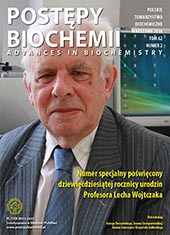Mitochondrial Hsp70 - function and evolution
Abstract
Hsp70 molecular chaperones function in variety of critical cellular processes, including protein folding, translocation of proteins across membranes and assembly/disassembly of protein complexes. Hsp70 systems consist of a core Hsp70 protein and its co-chaperones: J-protein and nucleotide release factor NRF. These co-chaperones regulate the cycle of interaction with protein substrate via stimulating the ATPase activity of Hsp70 (J-protein) and promoting nucleotide exchange (NRF). Compartments within the eukaryotic cell often
contain multiple Hsp70s, J-proteins and NRFs. The capabilities of these systems to carry out diverse cellular functions results from either specialization of an Hsp70 or by interaction of multifunctional Hsp70 with an array of specialized J-proteins. The well-studied Hsp70 systems of yeast mitochondria provide an excellent example of functional divergence and evolution of Hsp70 machineries.
Downloads
Published
Issue
Section
License
All journal contents are distributed under the Creative Commons Attribution-ShareAlike 4.0 International (CC BY-SA 4.0) license. Everybody may use the content following terms: Attribution — You must give appropriate credit, provide a link to the license, and indicate if changes were made, ShareAlike — If you remix, transform, or build upon the material, you must distribute your contributions under the same license as the original. There are no additional restrictions — You may not apply legal terms or technological measures that legally restrict others from doing anything the license permits.
Copyright for all published papers © stays with the authors.
Copyright for the journal: © Polish Biochemical Society.




